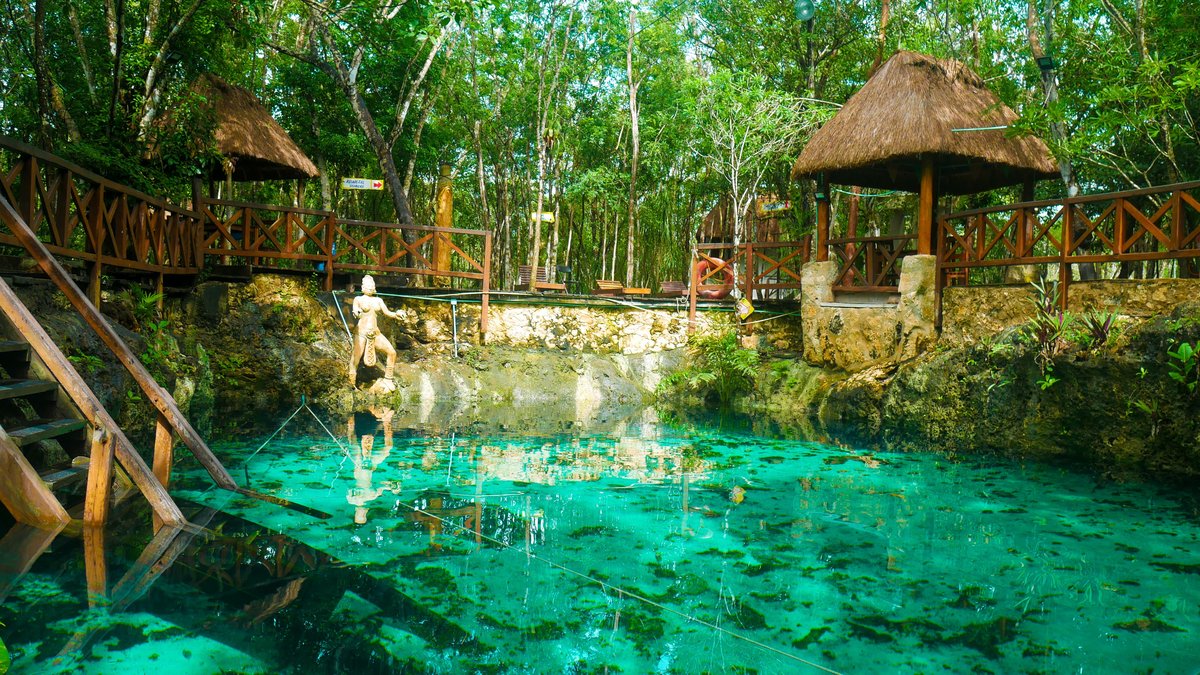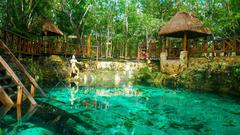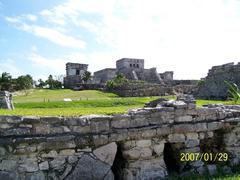
Cenote Zacil Ha Visiting Hours, Tickets, and Travel Guide – Tulum, Mexico
Date: 14/06/2025
Introduction: Location and Significance
Cenote Zacil Ha, located just minutes from Tulum in Mexico’s Yucatán Peninsula, is a captivating open cenote celebrated for its crystal-clear turquoise waters and lush jungle surroundings. Formed through the natural process of limestone karstification, Zacil Ha is part of a vast network of underground rivers that have shaped the region over millions of years (cenotes.net). This cenote holds profound historical and cultural significance, dating back to the Maya civilization, for whom cenotes were not only essential sources of fresh water but also revered as sacred portals to the underworld (ancientpedia.com; mayan.mythologyworldwide.com).
Today, Zacil Ha offers family-friendly activities, including swimming, snorkeling, ziplining, and relaxing picnic areas. Its proximity to Tulum’s archaeological sites, such as the Tulum Ruins and nearby cenotes, makes it an ideal destination for travelers seeking adventure, culture, and relaxation (thetulumbible.com; Info Quintana Roo). This guide provides essential information about Cenote Zacil Ha’s natural features, history, amenities, conservation efforts, visiting hours, ticket prices, and travel tips to help you plan a memorable and responsible visit.
Geological Formation
Cenote Zacil Ha exemplifies the karst landscape of the Yucatán Peninsula, where porous limestone bedrock has been dissolved by acidic rainwater, creating extensive caverns and underground rivers. When these subterranean chambers collapse, open cenotes like Zacil Ha are formed, exposing the water to the sky (cenotes.net). The cenote’s cool, clear waters (typically 22–25°C) and striking limestone formations make it ideal for swimming and snorkeling.
Maya Civilization: History and Mythology
Cenotes played a vital role for the ancient Maya, providing essential water in a region without surface rivers. Settlements, including those near Tulum, were established around cenotes to secure a reliable water supply (ancientpedia.com). Beyond their practical importance, cenotes were sacred in Maya cosmology, believed to be gateways to Xibalba, the underworld. Rituals, offerings, and sacrifices conducted at cenotes honored deities such as Chaak, the rain god (mayan.mythologyworldwide.com; thecenoteguy.com). Archaeological finds—including pottery and human remains—underscore their ceremonial significance (mexicohistorico.com).
Visiting Cenote Zacil Ha: Practical Information
Hours of Operation
- General Opening Hours: Daily, 10:00 AM – 6:00 PM (Info Quintana Roo)
- Some sources note earlier access (from 8:00 or 9:00 AM), but the most widely accepted current schedule is 10:00 AM – 6:00 PM. Arriving early is recommended to avoid crowds.
Ticket Prices
- Foreign Visitors: 300 MXN (approx. $15 USD)
- Mexican Nationals: 150 MXN
- Locals: 100 MXN
- Children: Discounted rates available; inquire at entrance
- Equipment Rental: Life jackets, lockers, and snorkel gear available for an additional fee
- Payment: Cash only (Mexican pesos); cards are not accepted (thetulumbible.com; absolute-adventure-mexico.com)
Getting There
- By Car: 8–10 km from central Tulum; ample on-site parking
- By Taxi: Readily available; agree on fare before departure
- By Colectivo: Shared vans run the Tulum–Coba route; request a stop at the cenote entrance
- By Bicycle: 30–60 minutes from Tulum town for adventurous travelers
Accessibility
- General: Wooden ramps and platforms facilitate access, but there are stairs and uneven terrain. Those with limited mobility should contact the site in advance to confirm accommodations.
- Facilities: Restrooms, changing rooms, outdoor showers, snack bar, shaded seating, and lockers are available (Info Quintana Roo).
Activities and Amenities
- Swimming & Snorkeling: Enjoy clear waters with good visibility and varied depths, suitable for both families and experienced swimmers.
- Zipline: Glide across the cenote and splash into the water—fun for all ages.
- Cliff Jump: A safe 3-meter jump for thrill-seekers.
- Shallow Pools: On-site pools for younger children or those less comfortable in the cenote.
- Picnic Areas: Shaded tables and hammocks for relaxation.
- Lifeguards: On duty for enhanced safety (everysteph.com).
Environmental and Safety Guidelines
- Biodegradable Sunscreen Only: Protect the cenote’s ecosystem by using eco-friendly products (Digital Nomad Couple).
- Mandatory Showers: Rinse off before entering the water.
- No Littering: Carry out all trash and support recycling efforts.
- Supervise Children: Especially in and around the water.
- No Diving from Unauthorized Heights: Observe posted safety instructions.
Travel Tips
- Bring: Swimsuit, towel, reusable water bottle, cash, water shoes, change of clothes, biodegradable sunscreen, and light snacks.
- Arrive Early: For fewer crowds and optimal photo opportunities.
- Check for Special Events: Occasionally, the cenote hosts eco-workshops or local celebrations.
- Combine Your Visit: With nearby attractions—such as Cenote Calavera, Gran Cenote, Tulum Ruins, and Coba archaeological site (lostbetweenoceans.com).
Nearby Attractions
- Tulum Archaeological Site: Iconic Mayan ruins overlooking the Caribbean.
- Cenote Calavera, Gran Cenote, Nicte Ha: Each offers a unique cenote experience.
- Coba Ruins: Explore ancient pyramids in a jungle setting.
Conservation Efforts
Cenote Zacil Ha is committed to sustainable tourism. Visitors are encouraged to respect environmental guidelines, support local conservation programs, minimize plastic use, and learn about ongoing eco-friendly initiatives (Digital Nomad Couple).
Frequently Asked Questions (FAQ)
Q: What are the visiting hours for Cenote Zacil Ha?
A: 10:00 AM – 6:00 PM daily (confirm before visiting for any seasonal changes).
Q: How much are tickets?
A: 300 MXN for foreigners, 150 MXN for Mexican nationals, 100 MXN for locals (cash only).
Q: Can I bring my own food?
A: Yes, picnic areas are provided.
Q: Are there lifeguards on duty?
A: Yes, for your safety.
Q: Is snorkeling gear available?
A: Yes, available for rent, but you can also bring your own.
Q: Is the cenote wheelchair accessible?
A: Some facilities are accessible, but the terrain may be challenging—contact the site in advance.
Visual Recommendations
Include high-quality images of the turquoise waters, zipline, and jungle surroundings with descriptive alt tags such as “Cenote Zacil Ha turquoise waters near Tulum.” Maps showing the location on Highway 109 and virtual tours (if available) are helpful for trip planning.
Conclusion
Cenote Zacil Ha stands out as an accessible, family-friendly destination blending natural beauty, cultural heritage, and recreational opportunity. Whether you’re swimming, ziplining, or exploring the Maya history of the region, Zacil Ha offers a memorable and meaningful experience. Plan ahead by checking current hours and ticket prices, follow all environmental guidelines, and consider combining your visit with nearby archaeological and natural attractions for a full Tulum adventure.
For more travel tips, sustainable tourism guides, and up-to-date information, download the Audiala app and follow us on social media.
Official References & Further Reading
- Cenote Zacil Ha at cenotes.net
- Importance of Cenotes in Maya Culture – ancientpedia.com
- The Mythical Significance of Cenotes in Maya Culture – mayan.mythologyworldwide.com
- How Cenotes Shaped the Ancient Maya Civilization – thecenoteguy.com
- The Importance of Yucatán’s Cenotes in Maya Rituals – mexicohistorico.com
- Ultimate Guide to Cenote Zacil Ha – thetulumbible.com
- Visitor Guide to Cenote Zacil Ha – Info Quintana Roo
- Sustainable Tourism in Tulum – Digital Nomad Couple
- Cenote Zacil Ha Full Visitors Guide – lostbetweenoceans.com
- Cenote Zacil Ha Zazil Ha – everysteph.com
- Cenote Tulum Ultimate Guide 2025 – absolute-adventure-mexico.com
- Cenote Zacil Ha Mexico – tulumtravelsecrets.com


